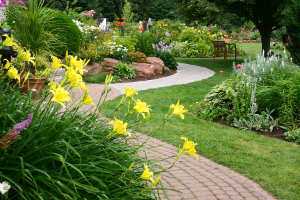You don’t need a full-scale meditation garden to recreate the peace and serenity of a traditional Oriental garden
Story: Emily Coakes, MAILDM
The appeal of the Orient extends far beyond matters of cuisine and art to the traditions, rituals and philosophies of countries such as China and Japan. Zen philosophy, for example, suggests that a profoundly peaceful, serene way of life is possible. Of course, achieving such serenity is an internal journey but the way we design and plant our outdoor spaces can go a long way to creating a conducive ambience – and Japanese garden design has a lot to offer for those seeking a sense of sanctuary.
The key is simplicity and an emphasis on natural elements such as pebble and stone, which rest easy in the Japanese inspired landscape. The goal is to create a gentle ambience and take the viewer on a journey. This might take the form of a path of random stone steppers set in grey gravel and edged with larger charcoal coloured river stones which leads to a resting place or a meandering path that leads around a fish filled pond.
A simple arching bridge of simple timber can create a sense of movement, even in smaller spaces, and carefully placed boulders mark the space as grounded and coherent, prepared to weather the storms of life. Combinations of rock colours and sizes add interest and variation from one area to another.
One need not create a full-scale meditation garden however to achieve this quietly voluminous feel; nature will play its integral part.
Few plants resonate so completely with an Asian inspired planting theme than the Japanese maple with its delicately patterned leaves which are shed and renewed with the seasons. And the cherry blossom, synonymous with romantic notions of still lakes and stylised tea ceremonies, are unmatched in their hidden spring splendour. There are several ornamental cherry tree species and cultivars available (some upright, some weeping, and some ideal as specimen plantings).
Feature trees are best selected for shape and texture rather than purely for their flowers. With this in mind, take a second look at the revered and ancient Ginkgo biloba tree with its fishtail fronds or the many stately and majestic coniferous specimens that conjure up thoughts of rocky peaks and wind swept plains.
By selecting from a planting palette that consists of no more than half a dozen plant types will help the aspiring gardener to ‘tie’ the theme together. Ultimate unification can be achieved via the grouping of selected plant species, set in contrast to a neighbouring tree or sculpture.
Azaleas and camellias are the perfect choice for those to whom the pruning shears beckon. Tamed to a tight bush, neat dome or wandering hedge, their manicured appearance is enhanced with an array of brilliant blooms each year.
Of course an Oriental garden would not be complete without bamboo – even just a hint – making its presence known. Now widely available there is a cultivar to suit every garden, large or small. Ideal as a screening or tall feature plant, slender weaver’s bamboo (Bambusa textilis var. gracilis) is by far the best for the average sized yard. Growing to around 6m tall and containable within a 1m garden bed, this majestic dense grower is in a class all of its own.
For smaller areas tiger grass (Thysanolaena maxima), which hails from Thailand, is an effective screening or feature plant. This perennial grass grows to about 3m and has attractive lance shaped leaves. Another good choice is Nandina domestica ‘Gulf Stream’, a dwarf form of nandina (more commonly known as Japanese sacred bamboo, although it isn’t actually a bamboo).
You can also take the road less traveled and use unusual specimens that harbour similar attributes to the more traditional choices. For an interesting ground cover, ask at your local nursery to view the latest range of prostrate Banksia species. Neat and with needle like foliage these remarkable plants will blend beautifully into an Oriental garden design and provide good coverage. A more common but no less appealing choice is black mondo (Ophiopogon planiscapus ‘Nigrescens’), an effective edging plant or ground cover,
Introducing the continual movement and gentle sound of water will add to the harmony and fluidity of the space. A stone bowl and bubbler surrounded by pebbles is an effective focal point, as is a simple water bowl with goldfish and graceful dwarf papyrus (Cyperus papyrus ‘Nana’).
Wood elements can be introduced in the form of bamboo panels or pre-twined bamboo or natural reed screening which can be used to clad an ugly wall or mask an unsightly shed.
A contented Buddha statue speaks of tranquility when nestled among a group of ferns or sent in a garden bed. A well placed stone sculpture of a pagoda or a carved stone lantern invites peaceful energies into a garden. Try incorporating a stone bench or wooden garden seat to give a garden a sense of age and provide a place to rest after a hard days work.
However you choose to express your interest in the Oriental inspired garden, this is a style of garden design that can give you an outdoor living space filled with a sense of peace and natural harmony.
This article was prepared by Emily Coakes, a landscape designer and horticultural consultant with Boyd’s Bay Landscape & Environment, on behalf of the Australian Institute of Landscape Designers & Managers (AILDM). If you would like to find an AILDM member in your area, visit the website: www.aildm.com.au.






